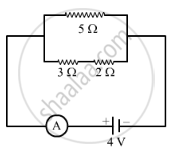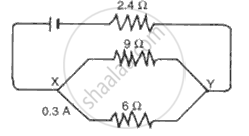Advertisements
Advertisements
Question
In which of the following cases more electrical energy is consumed per hour?
(i) A current of 1 ampere passed through a resistance of 300 ohms.
(ii) A current of 2 amperes passed through a resistance of 100 ohms.
Solution
(i) I = 1 A
R = 300 Î
t = 1 h
Electrical energy consumed = `I^2xxRxxt`
= (1)2 (300) (1)
= 300 Wh
(ii) I = 2 A
R = 100 Î
Electrical energy consumed = `I^2xxRxxt=(2)^2(100)(1)=400Wh`
Thus, more electrical energy is consumed in case (ii).
APPEARS IN
RELATED QUESTIONS
Fill in the blank:
To increase the effective resistance in a circuit the resistors are connected in _____________.
How many milliamperes as there in 1 ampere?
(a) With the help of a circuit diagram, obtain the relation for the equivalent resistance of two resistances connected in parallel.
(b) In the circuit diagram shown below, find:
(i) Total resistance.
(ii) Current shown by the ammeter A

Draw a circuit diagram showing two electric lamps connected in parallel together with a cell and a switch that works both lamps. Mark an â’¶ on your diagram to show where an ammeter should be placed to measure the current.
Which effect of current is utilised in an electric light bulb?
Define the following:
Electromotive force
A current of 0.3 A is flowing through a branch of 6 Ω resistors in a junction as shown in fig. . Calculate the
(a) P.d. across the junction XY,
(b) Current flowing through 9Ω and 24Ω
( c) P.d. across 24 Ω resistor, and
( d) e.m.f. of the cell.

One unit of electrical energy consumed is equal to 1000 kilowatt-hour.
- What is meant by electric current?
- Name and define its unit.
- Which instrument is used to measure the electric current? How should it be connected in a circuit?
